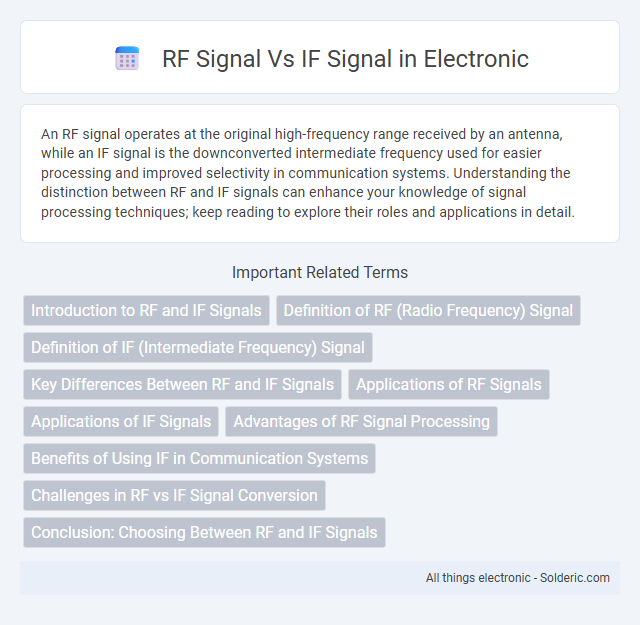An RF signal operates at the original high-frequency range received by an antenna, while an IF signal is the downconverted intermediate frequency used for easier processing and improved selectivity in communication systems. Understanding the distinction between RF and IF signals can enhance your knowledge of signal processing techniques; keep reading to explore their roles and applications in detail.
Comparison Table
| Feature | RF Signal (Radio Frequency) | IF Signal (Intermediate Frequency) |
|---|---|---|
| Frequency Range | Typically from 3 kHz to 300 GHz | Fixed lower frequency, usually between 10 kHz and a few hundred MHz |
| Purpose | Initial frequency of transmitted or received signals | Converted frequency for easier signal processing and filtering |
| Signal Processing | Complex, requires high-frequency components | Simplified, uses standard, lower-frequency components |
| Applications | Wireless communication, broadcasting, radar | Superheterodyne receivers, signal demodulation |
| Noise Sensitivity | Higher due to higher frequency and longer path | Lower, enabling improved selectivity and sensitivity |
| Example Frequencies | FM radio (~88-108 MHz), Wi-Fi (~2.4 GHz) | Typically 455 kHz (AM radios), 10.7 MHz (FM radios) |
Introduction to RF and IF Signals
RF (Radio Frequency) signals range from 3 kHz to 300 GHz and are used for wireless communication, broadcasting, and radar systems. IF (Intermediate Frequency) signals are typically lower-frequency signals, produced by mixing an RF signal with a local oscillator signal to simplify processing and improve selectivity in receivers. Converting RF signals to IF signals enhances filtering, amplification, and demodulation in communication devices and radar applications.
Definition of RF (Radio Frequency) Signal
RF (Radio Frequency) signal refers to electromagnetic waves within the frequency range of 3 kHz to 300 GHz, used for wireless communication and broadcasting. These signals carry information through the air by oscillating at specific frequencies, enabling transmission over long distances without physical connections. Your devices rely on RF signals to send and receive data, making them essential in applications like radio, television, and cellular networks.
Definition of IF (Intermediate Frequency) Signal
An Intermediate Frequency (IF) signal is a frequency to which a received Radio Frequency (RF) signal is converted during the superheterodyne process in communication systems. The IF signal simplifies signal processing by providing a fixed frequency that allows for easier filtering, amplification, and demodulation compared to the original RF signal. Typical IF frequencies range from a few hundred kilohertz to several megahertz, optimizing performance in radios, televisions, and radar equipment.
Key Differences Between RF and IF Signals
RF signals operate at higher frequencies directly transmitted or received by antennas, typically ranging from several MHz to GHz, while IF signals are lower-frequency signals produced by frequency conversion to facilitate easier processing and filtering within receivers. The key difference lies in their roles: RF signals carry the original information over the air, whereas IF signals act as intermediary frequencies in superheterodyne receiver architectures for improved selectivity and sensitivity. Understanding these distinctions helps optimize your design and troubleshooting of communication systems by choosing appropriate filtering and amplification stages.
Applications of RF Signals
RF signals play a crucial role in wireless communication systems, including radio broadcasting, cellular networks, and satellite transmissions. These signals enable the transmission of data over long distances by modulating information onto high-frequency electromagnetic waves. Your devices rely on RF signals for applications such as Wi-Fi connectivity, Bluetooth communication, and radar detection, making them essential for modern telecommunications and sensing technologies.
Applications of IF Signals
IF signals are extensively used in communication systems such as radar, satellite receivers, and TV tuners due to their easier processing and improved stability compared to RF signals. By converting high-frequency RF signals to a lower intermediate frequency, your devices can perform signal amplification, filtering, and demodulation with greater precision and reduced noise. This frequency conversion enables efficient handling of signals in radios, wireless communication, and signal processing equipment.
Advantages of RF Signal Processing
RF signal processing offers the advantage of direct access to the original high-frequency information, enabling real-time detection and analysis without the need for frequency conversion. It reduces noise and interference introduced by additional mixing stages, improving signal integrity and overall system sensitivity. Furthermore, RF processing simplifies system architecture by minimizing components, which enhances reliability and reduces power consumption.
Benefits of Using IF in Communication Systems
Intermediate Frequency (IF) signals offer significant advantages in communication systems by simplifying signal processing and improving selectivity and sensitivity. Your system can achieve better noise rejection and easier filtering compared to directly processing high-frequency Radio Frequency (RF) signals. Using IF signals enables more precise amplification and modulation, enhancing overall performance and reliability in communication devices.
Challenges in RF vs IF Signal Conversion
RF signal conversion faces significant challenges including high-frequency signal attenuation, increased noise susceptibility, and complex impedance matching requirements, which complicate the design of efficient front-end circuits. IF signal conversion typically encounters fewer losses and noise issues, but demands precise filtering and frequency stability to avoid distortion and maintain signal integrity. Both conversions require careful management of linearity, phase noise, and unwanted intermodulation products to ensure overall system performance.
Conclusion: Choosing Between RF and IF Signals
RF signals carry information at the original transmission frequency, offering direct communication but often facing higher noise and interference. IF signals, converted to a fixed intermediate frequency, enable easier filtering and amplification, enhancing signal processing and system stability. Your choice between RF and IF signals depends on factors like system complexity, noise tolerance, and application requirements.
RF signal vs IF signal Infographic

 solderic.com
solderic.com